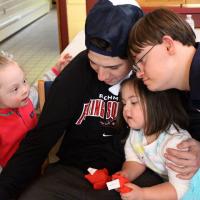In this lesson, the students learn to use their voice to say something to make the world a better place. This is an opportunity to demonstrate and feel the impact of kindness, inclusion, and listening on a caring community. Students learn from a community helper about the needs they observe in the community. They make and donate a "calming box" so the tool may help youth calm themselves. Use this at the beginning of the year to set a tone and learn skills of effective language that are good for all.
- Read more about Words Bring Peace (elementary)
- Log in or register to post comments
